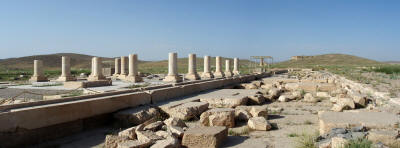
|
|
4-8 June 2007, Homa Hotel (5*), Shiraz, Iran
(Also Persepolis, Pasargadae, Firuzabad, Kazerun)
|
|
Pasargadae
The majestic simplicity of the architecture at Pasargadae reflects a sense of balance and beauty that was never equalled in either earlier or later Achaemenian times. The principal buildings stand in magnificent isolation, often with a common orientation but scattered over a remarkably wide area. Although no single wall enclosed the whole site, a strong citadel commanded the northern approaches. The dominant feature of the citadel is a huge stone platform, projecting from a low, conical hill. Two unfinished stone staircases and a towering facade of rusticated masonry were evidently intended to form part of an elevated palace enclosure. An abrupt event, however, brought the work to a halt, and a formidable mud-brick structure was erected on the platform instead. It is possible that the building represents the famous treasury surrendered to Alexander III of Macedonia in 330 BC.
To the south of the citadel was an extensive walled park with elaborate, irrigated gardens surrounded by a series of royal buildings. One building, designed as the sole entrance to the park, is notable for a unique four-winged, crowned figure that stands on a surviving doorjamb; the figure appears to represent an Achaemenian version of the four-winged genius (guardian spirit) found on palace doorways in Assyria.
Farther to the south, the tomb of Cyrus the Great still stands almost intact. Constructed of huge, white limestone blocks, its gabled tomb chamber rests on a rectangular, stepped plinth, with six receding stages. In Islamic times the tomb acquired new sanctity as the supposed resting place of the mother of King Solomon. At the extreme southern edge of the site, an impressive rock-cut road or canal indicates the course of the ancient highway that once linked Pasargadae with Persepolis.
After the accession of Darius I the Great (522 BC), Persepolis replaced Pasargadae as the dynastic home.
|
|
|
399 to 400. Achaemenian stone platform known as "Tall-e Takht" or "Solomon's Throne" is a huge fortified terrace over 80 m long and 18 m wide and is believed to have been the foundation of a palace. See the satellite image by Google Map. |
|||
| 401 to 403. "Tall-e Takht" or "Solomon's Throne" | |||
|
404. A panoramic view of Pasargadae plain from the top of Tall-e Takht |
|||
|
405. Another panoramic view of Pasargadae plain from the top of Tall-e Takht |
|||
|
406. Wild plants grown on the top of Tall-e Takht |
407. Three remained pedestal on the top of Tall-e Takht |
||
|
408. "Solomon's Prison", at the foot of the hillock, remains of a building similar to the Kaaba of Zoroaster in the Naqsh e Rostam necropolis can be seen. some scholars believe it was a fire-temple, others assert that it was a tomb and some argue that this was a shrine of some sort. The existence of two identical buildings one in Pasargadae and another in the Persepolis area is however a matter of significance and as there are no tombs near the Pasargadae remains of this square building, it can be surmised that the building was more of a shrine than either a tomb or a fire-temple and it probably housed the sacred book and the arch-priest during religious rituals. Here, as in the case of the Throne of Solomon, the Mohammedan tradition (1000 years later) has overlaid earlier history and the building has come to be known as the "Prison of Solomon". Even the tomb of Cyrus the Great is called "Mausoleum of Mother of Solomon", maybe a neat trick of the Persians themselves to make the fanatical Arab invaders respect these edifices and spare them. See the satellite image by Google Map. |
|||
|
409.1. |
409.2. |
||
|
410. |
411. |
412. |
|
|
413. |
414. |
||
|
415. |
416. |
419. |
417. |
|
418. |
420. |
||
|
421. |
422. |
425. |
|
|
423. |
424. |
||
|
426. |
427. |
428. |
|
|
|
|
|








